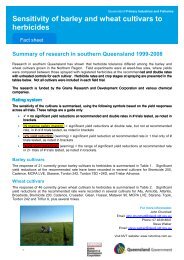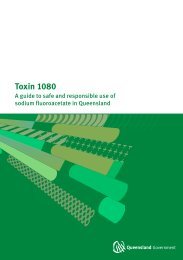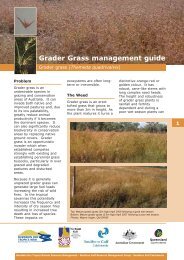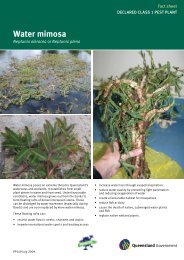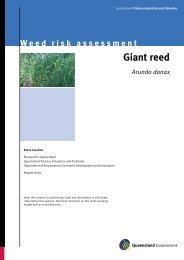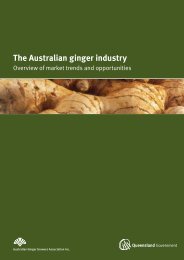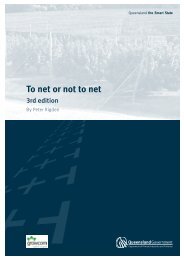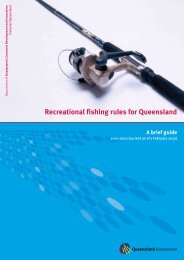Pest plant risk assessment: Blue stars—Aristea ecklonii
Pest plant risk assessment: Blue stars—Aristea ecklonii
Pest plant risk assessment: Blue stars—Aristea ecklonii
Create successful ePaper yourself
Turn your PDF publications into a flip-book with our unique Google optimized e-Paper software.
Queensland the Smart State<br />
<strong>Pest</strong> <strong>plant</strong> <strong>risk</strong> <strong>assessment</strong><br />
Steve Csurhes<br />
Biosecurity Queensland<br />
Department of Primary Industries<br />
and Fisheries, Queensland<br />
GPO Box 46, Brisbane Qld 4001<br />
August 2008<br />
<strong>Blue</strong> stars<br />
Aristea <strong>ecklonii</strong>
PR08–3664<br />
The Department of Primary Industries and Fisheries (DPI&F) seeks to maximise the economic<br />
potential of Queensland’s primary industries on a sustainable basis.<br />
While every care has been taken in preparing this publication, the State of Queensland<br />
accepts no responsibility for decisions or actions taken as a result of any data, information,<br />
statement or advice, expressed or implied, contained in this report.<br />
© The State of Queensland, Department of Primary Industries and Fisheries 2008.<br />
Copyright protects this material. Except as permitted by the Copyright Act 1968 (Cwlth),<br />
reproduction by any means (photocopying, electronic, mechanical, recording or otherwise),<br />
making available online, electronic transmission or other publication of this material is<br />
prohibited without the prior written permission of the Department of Primary Industries and<br />
Fisheries, Queensland.<br />
Inquiries should be addressed to copyright@dpi.qld.gov.au (tel: +61 7 3404 6999), or:<br />
Director<br />
Intellectual Property Commercialisation Unit<br />
Department of Primary Industries and Fisheries<br />
GPO Box 46<br />
Brisbane Qld 4001
Contents<br />
Summary 2<br />
Identity and taxonomy 2<br />
Description 2<br />
Origin and distribution 3<br />
Status in Queensland 4<br />
Prefered habitats 5<br />
Reproduction, dispersal and seed longevity 5<br />
History as a weed overseas 5<br />
Uses 6<br />
Related species 6<br />
<strong>Pest</strong> potential in Queensland 7<br />
References 8<br />
P e s t p l a n t r i s k a s s e s s m e n t : <strong>Blue</strong> stars Aristea <strong>ecklonii</strong><br />
1
Summary<br />
A. <strong>ecklonii</strong> is a small (c. 70 cm tall), rhizomatous perennial native to Africa. It is a popular<br />
garden ornamental in Australia and overseas, where it is grown for its attractive blue<br />
flowers. It has escaped from gardens to become an unwanted ‘weed’ in New Zealand,<br />
New South Wales and Victoria. At some sites, overseas and interstate, it has formed<br />
dense stands over small areas and is probably still spreading. As such, it is predicted to<br />
become a weed within comparable habitat types and climate zones in Queensland. Based<br />
on climatic and habitat information from its native range, habitats at <strong>risk</strong> of invasion<br />
appear to be limited to open or otherwise disturbed sites in mesic, upland rainforests<br />
in subtropical Queensland (open grassy areas/pastures, roadsides, tracks and riparian<br />
habitats). Remaining areas of the state are predicted to be either too hot or dry. While this<br />
study found evidence that this species is having an impact as a weed elsewhere, the exact<br />
nature of these impacts is poorly described in the literature. While it seems reasonable to<br />
predict that A. <strong>ecklonii</strong> will become more abundant in the future within suitable habitats of<br />
Queensland, a lack of information on the nature and scale of impacts makes predictions on<br />
its potential impacts in Queensland very difficult to make.<br />
Identity and taxonomy<br />
Species identity: Aristea <strong>ecklonii</strong><br />
Common names: <strong>Blue</strong> stars, blue-eyed iris (New Zealand), blue corn lily (New Zealand),<br />
blousterre (Afrikaans), phayimashimane (Swaziland), ikhambi eliluhlaza,<br />
ikkwanyana, umabhanjana, umafosi, umhushuza (Zulu).<br />
Taxonomy: Family—Iridaceae<br />
Aristea comprises c. 50 species (Goldblatt et al. 2004).<br />
Description<br />
A. <strong>ecklonii</strong> is a spreading, evergreen, rhizomatous perennial with stiff, upright, grass-like<br />
leaves. It grows 30–70 cm tall in a tight clump. In spring or early summer its flowering stalks<br />
become covered with dozens of small, blue, saucer-shaped flowers standing above the<br />
leaves. Each flower lasts for one day and only opens in bright light.<br />
The Royal Botanic Gardens Sydney (2007) describes the <strong>plant</strong> as follows:<br />
‘Basal leaves 3–11, linear to falcate, 10–60 cm long, 5–11 mm wide, usually thin<br />
and subleathery, venation moderately pronounced, leaf bases usually red; cauline<br />
leaves 2–5, smaller. Scape compressed, slightly winged; spathe bracts 5–14 mm<br />
long, apex finely acuminate and green to rusty brown, margins hyaline, rusty<br />
brown; inner bracts similar, slightly smaller. Flowers in loose panicle, opening<br />
for a few hours only, pedicels 2–10 mm long. Perianth c. 12 mm long; tube very<br />
short, green; outer lobes about two-thirds the size of inner ones, bright blue. Style<br />
unbranched or shortly 3–lobed. Capsule oblong, triquetrous, c. 20 mm long; seeds<br />
numerous, c. 1.5 mm long, circular and angular-compressed, surfaces reticulate.’<br />
P e s t p l a n t r i s k a s s e s s m e n t : <strong>Blue</strong> stars Aristea <strong>ecklonii</strong><br />
2
Origin and distribution<br />
Species within the Aristea genus are native to sub-Saharan Africa and Madagascar (Goldblatt<br />
et al. 2004), with about 40 species native to southern Africa, eight native to tropical Africa<br />
and six native to Madagascar (Goldblatt 1995).<br />
A. <strong>ecklonii</strong> is native to central and southern Africa. According to GRIN (2007), its native range<br />
is as follows:<br />
• eastern tropical Africa: Uganda<br />
• west-central tropical Africa: Burundi, Cameroon, Rwanda, Zaire<br />
• southern tropical Africa: Mozambique, Zimbabwe<br />
• southern Africa: Cape Province, Natal, Transvaal, Swaziland.<br />
While its range extends into tropical areas, it appears to be restricted to cooler, highland<br />
habitats. For example, in Cameroon, it has been collected from wet, upland grasslands<br />
(above 4500 feet) (Royal Botanic Gardens, Kew). In southern (subtropical) Africa, it appears<br />
to occur at lower elevations. In South Africa, it can be found all along the Drakensberg and in<br />
many gardens.<br />
The genus Aristea has a pronounced centre in southern Africa and a centre of diversity in the<br />
winter rainfall zone, with only one species extending eastward into the adjacent southern<br />
edge of the summer rainfall zone (Goldblatt et al. 2005).<br />
In Australia, A. <strong>ecklonii</strong> has been recorded from Victoria and New South Wales (with a new<br />
record from Queensland) (Figure 1).<br />
P e s t p l a n t r i s k a s s e s s m e n t : <strong>Blue</strong> stars Aristea <strong>ecklonii</strong><br />
3
Figure 1. Locations where A. <strong>ecklonii</strong> has been collected and recorded by Australian herbaria<br />
(source: Australian Virtual Herbarium).<br />
Status in Queensland<br />
A. <strong>ecklonii</strong> was first collected in Queensland at Springbrook (south-east Queensland) by<br />
A. Keto in October 2007 (herbarium record below). To date, this is the only documented site<br />
for this species, although it is likely to be quite common in gardens elsewhere.<br />
Collection details:<br />
AQ Number: 751858 (ID Number: 1401)<br />
Collection date: 29 October 2007<br />
Location: Grid ref: 527 836 6877 705 at 820 m<br />
Notes: Eastern Springbrook—property purchased by the Queensland Government—<br />
large spreading population of Aristea—more profilic in shade, soils based on<br />
rhyolite, in rainfall zone >3000 mm per annum.<br />
Abundance: 3 ha of <strong>plant</strong>s—146 <strong>plant</strong>s per m 2 .<br />
P e s t p l a n t r i s k a s s e s s m e n t : <strong>Blue</strong> stars Aristea <strong>ecklonii</strong><br />
4
Prefered habitats<br />
In tropical areas, A. <strong>ecklonii</strong> appears to be restricted to cool, wet, upland habitats (such as<br />
open grasslands). In subtropical areas, such as South Africa, it occurs in forest margins,<br />
streambanks, grassland and shrubland, often in shady areas.<br />
When cultivated in the garden, it is reported to grow best in humus-rich, well-drained soil<br />
with plenty of moisture and full sun (Floridata 2007).<br />
Reproduction, dispersal and<br />
seed longevity<br />
A. <strong>ecklonii</strong> spreads primarily from seeds, which are produced in abundance. However, it can<br />
also be propagated by dividing rhizomes, tubers, corms or bulbs (including offsets).<br />
Seeds are reported to be dispersed by water (Carr et al. 1992), wind or gravity (Aukland<br />
Regional Council 2007).<br />
History as a weed overseas<br />
A. <strong>ecklonii</strong> is listed as a weed in New Zealand (Biosecurity New Zealand 2007) where it grows<br />
in extensive patches within native vegetation, along roadsides, tracks, streamsides and in<br />
open forest (e.g. kauri) (Auckland Regional Council 2007).<br />
In Australia, A. <strong>ecklonii</strong> has escaped from gardens to form wild (naturalised) populations<br />
in Victoria and New South Wales. Currently, these populations are still small. In Victoria,<br />
it is considered to pose a threat to riparian vegetation and dry sclerophyll forest/woodland<br />
(Carr et al. 1992; Csurhes & Edwards 1998). In New South Wales, it inhabits disturbed<br />
woodland on the central coast and in the Sydney area (Harden 1993; Csurhes & Edwards<br />
1998). In Warringa Shire (New South Wales), although not declared, it is listed on a ‘register’<br />
of environmental weeds (Warringah online 2007).<br />
In both Victoria and New South Wales, A. <strong>ecklonii</strong> appears to be spreading with additional<br />
naturalised populations being detected. For example, in 2007, it was discovered on several<br />
roadsides in Latrobe City (Victoria) (LaTrobe City Council media release 2007). There are now<br />
several small populations derived from garden <strong>plant</strong>s on roadsides around Moe, Newborough<br />
and Yallourn North.<br />
P e s t p l a n t r i s k a s s e s s m e n t : <strong>Blue</strong> stars Aristea <strong>ecklonii</strong><br />
5
Uses<br />
A. <strong>ecklonii</strong> is a popular garden <strong>plant</strong> grown for its attractive blue flowers and low, clumping<br />
habit. It is often <strong>plant</strong>ed as a ground cover on the edges of gardens or along the borders of<br />
paths and ponds.<br />
Most species within the genus are rarely grown. However, A. <strong>ecklonii</strong> seems to be the most<br />
commonly grown species within the genus (Pacific Bulb Society 2007), perhaps due to its<br />
hardiness and ease of propagation. One gardening internet site comments that ‘all Aristea are<br />
beautiful, but unfortunately not all of them are so easy to grow’.<br />
Currently, A. <strong>ecklonii</strong> is a permitted import under AQIS regulations.<br />
Related species<br />
From Pacific Bulb Society website (2007):<br />
A. abyssinica is found from the Eastern Cape, South Africa to tropical Africa where<br />
it grows in on rocky outcrops, in grassland and marshy areas. It has narrow leaves,<br />
clustered at the base and sky blue, violet, deep red or pink flowers.<br />
A. africana is an evergreen, short <strong>plant</strong> with blue flowers and a style with three<br />
fringed lobes. It is found on sandy flats and mountain slopes in the winter rainfall<br />
area of South Africa.<br />
A. bakeri (syn. A. confusa) is an evergreen rhizomatous <strong>plant</strong> found on stony<br />
sandstone slopes in the Cape province of South Africa. It can grow to one metre tall.<br />
The flowers are short-lived (they do not even last for one day) and blue.<br />
A. biflora is native to the south-west Cape of South Africa. It has large lilac to purple<br />
flowers with transparent to translucent bronze windows on the lower margins.<br />
A. capitata (syn. A. major) is an evergreen rhizomatous species that grows up to 1.5<br />
m tall. It is a striking species with many blue flowers. It occurs over a wide range of<br />
the Cape growing on mountain slopes and blooming spring to summer.<br />
A. cantharophila grows on clay and granite slopes in fynbos or renosterveld in the<br />
south-west Cape.<br />
A. <strong>ecklonii</strong> is a summer rainfall Aristea. It grows on forest margins, streambanks,<br />
grassland and scrub from the Eastern Cape to Tanzania. It has basal leaves<br />
arranged in a fan shape and mauve-blue flowers. It flowers early in the morning<br />
and the flowers fade by afternoon, but it can bloom throughout the year. When<br />
grown in a well- watered garden is important to remove seedheads to avoid a<br />
proliferation of seedlings.<br />
A. lugens grows on low, granitic hills in renosterveld in the south-west Cape, South<br />
Africa. Plants are evergreen and rhizomatous with striking pale blue to white flowers<br />
with dark blue-black outer tepals.<br />
P e s t p l a n t r i s k a s s e s s m e n t : <strong>Blue</strong> stars Aristea <strong>ecklonii</strong><br />
6
A. oligocephala is found on sandstone slopes from the Hottentots Holland<br />
Mountains to Bredasdorp (South Africa). Flowers are blue and the style has three<br />
finged lobes.<br />
A. spiralis is found on rocky sandstone and granite slopes from the Cape peninsula<br />
to Kynsna (South Africa). Flowers face to the side and are white or pale blue.<br />
A. teretifolia grows in the south-west Cape on low, clay hills in renosterveld. Flowers<br />
are large, lilac to cream. Tepals are unequal; the inner has a large dark mark toward<br />
the base.<br />
<strong>Pest</strong> potential in Queensland<br />
A. <strong>ecklonii</strong> has a history as a weed in New Zealand and interstate (New South Wales and<br />
Victoria). As such, it is predicted to become a weed within comparable habitat types and<br />
climate zones in Queensland.<br />
Based on climatic and habitat information from its native range, habitats at <strong>risk</strong> of invasion<br />
appear to be limited to open or otherwise disturbed sites in mesic, upland rainforests in subtropical<br />
Queensland (open grassy areas/pastures, roadsides, tracks and riparian habitats).<br />
Remaining areas of the state are predicted to be either too hot or dry.<br />
Even though A. <strong>ecklonii</strong> is listed as a weed interstate and overseas, there is very limited<br />
information available on its impact. It is reported to be replacing native vegetation in New<br />
Zealand, but the scale of such impacts is poorly described.<br />
A. <strong>ecklonii</strong> is in an early stage of invasion in Queensland and could become a significant pest<br />
within suitable habitats after its population has had sufficient time to develop.<br />
P e s t p l a n t r i s k a s s e s s m e n t : <strong>Blue</strong> stars Aristea <strong>ecklonii</strong><br />
7
References<br />
Anon. (2007). www.pacificbulbsociety.org/pbswiki/index.php/Aristea<br />
Aukland Regional Council (2007). <strong>Pest</strong> <strong>plant</strong> information sheet,<br />
http://shadoadmin.arc.govt.nz/<strong>plant</strong>s/<strong>plant</strong>details.cfm?<strong>plant</strong>code=Arieck<br />
Biosecurity New Zealand (2007).<br />
www.biosecurity.govt.nz/pest-and-disease-response/pests-and-diseases-watchlist/aristea<br />
Carr, GW, Yugovic, JV and Robinson, KE (1992). Environmental weed invasions in Victoria—<br />
conservation and management implications, Department of Conservation and Environment<br />
and Ecological Horticulture, Victoria.<br />
Csurhes, S and Edwards, R (1998). Potential environmental weeds in Australia: candidates for<br />
preventative control, Environment Australia, Canberra.<br />
Floridata (2007). www.floridata.com/ref/A/aris_eck.cfm<br />
Goldblatt, P (1995). ‘Notes on Aristea Aiton (Iridaceae: Nivenioideae): taxonomy, chromosome<br />
cytology and phylogeny’. Annals of the Missouri Botanic Gardens, 82, 139–145.<br />
Goldblatt, P, Le Thomas, A. and Suarez-cervera, M (2004). ‘Phylogeny of the Afro-<br />
Madagascan Aristea (Iridaceae) revisited in the light of new data on pollen morphology’.<br />
Botanical Journal of the Linnean Society 144, 41–68.<br />
Goldblatt, P, Dold, AP, Manning, JC (2005). ‘Three cryptic new species of Aristea (Iridaceae)<br />
from southern Africa’. Bothalia 35, 1–6.<br />
GRIN (2007). Germplasm Resource Information Network, United States Department of<br />
Agriculture database. www.ars-grin.gov/cgi-bin/npgs/html/taxon.pl?4026<br />
LaTrobe City Council media release (2007). ‘Are you growing the next Paterson’s curse?’<br />
www.latrobe.vic.gov.au/MediaRoom/NewsReleases/Details/Default.aspx?PrintFriendly=<br />
1&NewsID=109<br />
Royal Botanic Gardens Sydney (2007). http://<strong>plant</strong>net.rbgsyd.nsw.gov.au/cgi-bin/NSWfl.pl?<br />
page=nswfl&lvl=sp&name=Aristea~<strong>ecklonii</strong><br />
Warringa online (2007). www.warringah.nsw.gov.au/environment/noxious_weeds_list.aspx<br />
P e s t p l a n t r i s k a s s e s s m e n t : <strong>Blue</strong> stars Aristea <strong>ecklonii</strong><br />
8
PR08_3664





